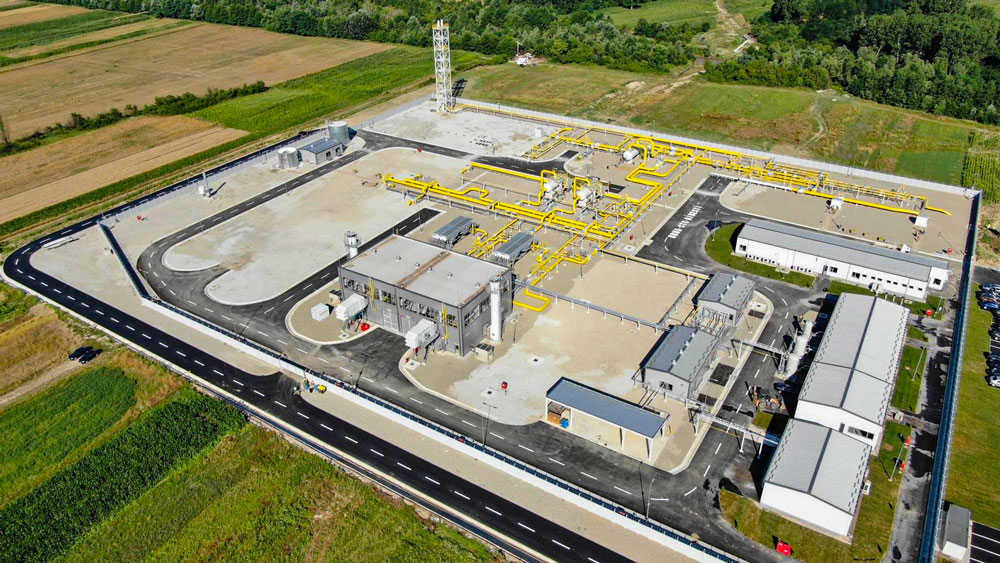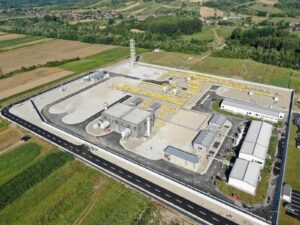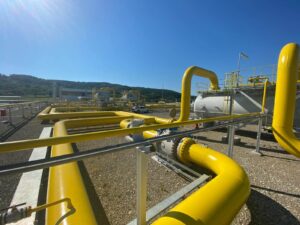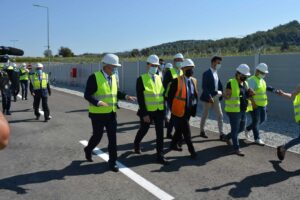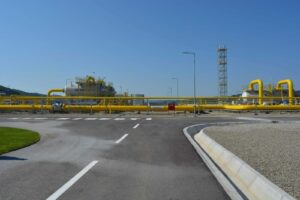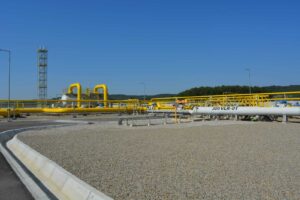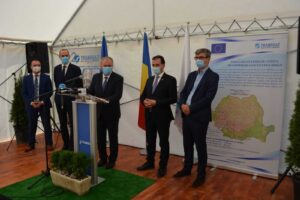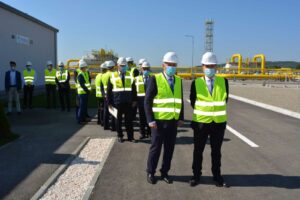BRUA Phase 1, Bibesti Gas Compressor Station Completed
Transgaz has completed works at the third and last gas compressor station within BRUA project Phase 1, the one in Bibesti, Gorj County. The inauguration of the station took place on August 23 and the event was attended by Romanian Prime Minister Ludovic Orban, together with Minister of Economy, Energy and Business Environment Virgil Daniel Popescu and other government officials, as well as the General Manager of SNTGN Transgaz SA, Ion Sterian, and representatives of the executive management of the company and of local public authorities.
It is the third and last compressor station within BRUA project Phase 1, which Transgaz commissions, after the inauguration and commissioning in 2019 of gas compressor stations in Jupa-Caras Severin County (September 30, 2019) and Podisor-Giurgiu County (October 31, 2019).
The purpose of Bibesti gas compressor station is to compress gas in order to offset pressure losses inherent in the gas transmission process. The station is bidirectional, being able to compress gas both to Podisor/Giurgiu direction and to the Jupa/Nadlac direction. Bibesti Gas Compressor Station is a technological facility interconnected to the following main gas pipelines: Dn 32″ GCS Podisor – GCS Bibesti, Dn 32″ GCS Bibesti – GCS Jupa, Dn 20″ GCS Bibesti – TN Hurezani.
The Bibesti Compressor Station is part of Phase 1 of BRUA gas pipeline, a strategic project which was approved, supported and financed at European level, obviously with Transgaz co-funding.
“The government supports the ambitious investment plan designed by Transgaz. We have a number of other extremely important investments that are taking place or will take place. Of course, the objectives we pursue are, on the one hand, a better interconnection, a diversification of gas supply sources in order to increase Romania’s energy security; we also aim, as objective, to expand main gas pipelines in as many areas in Romania as possible, to allow connection to gas networks, so that Romanian gas serves Romanians, reaches the homes of Romanians, reaches local communities and especially provides a support for programs for the development of local communities… In parallel with Transgaz’s investments, the Government has already designed and is already implementing a program to finance gas distribution, to expand local gas networks.
On August 17, as promised, we launched the call for projects to which administrative and territorial units, local administrations can apply, either single localities, or IDAs, or localities that associate in a partnership for the development of gas networks. The initial amount allocated for this smart grid expansion program in local communities is 234 million in the first phase, from the multiannual financial year 2014 – 2020,” PM Orban said on this occasion.
In turn, SNTGN Transgaz General Manager Ion Sterian said: “BRUA gas pipeline is not a highway without discharge, BRUA will be an integral part of the National Gas Transmission System, a factor of energy security and a driver for national economic development. Natural gas will reach Europe through TAP gas pipeline from the LNG terminals in northern Greece, from Revithoussa and Alexandroupolis, and further, from the Vertical Corridor Greece-Bulgaria-Romania, ensuring bidirectional transmission capacities of 1.5bcm/year in/from Bulgaria and 1.75bcm/year in/from Hungary. We have always worked on several levels, BRUA being one of our most important projects, but no by far the only one. We have worked in parallel at the Ungheni-Chisinau gas pipeline, a geostrategic project for Romania and the Republic of Moldova and which we commissioned in late July, according to the assumed commitments. In all this time, we have always considered the NTS development works in various regions of the country, as well as those from the north-east of the country or in the south, through Craiova-Segarcea-Calafat pipeline, where we have also inaugurated the Craiova-Segarcea section”.
European co-funding of EUR 179mln
GCS Bibesti is part of BRUA project Phase 1, which is on the list of projects of common interest (PCI – 7.1.5) of the European Union and is developed in the context of the need to diversify gas sources in EU countries. BRUA project Phase 1 aims to ensure access to new gas sources, as well as facilitate Caspian gas transport to markets in Central and Eastern Europe.
BRUA Phase 1 project has benefited from grant from the European Union of approximately EUR 179mln to implement the investment, which will ensure access to new gas sources, as well as facilitate gas transmission from the Caspian region to the markets of Central and Eastern Europe.
The project is developed in the context of the need to diversify gas sources in European Union countries and ensures bidirectional transmission capacities in/from Bulgaria and in/from Hungary.
Development projects worth EUR 4bn
BRUA project is an integral part of the ‘Plan for the Development of the National Gas Transmission System during 2019-2028’, approved in early March this year. The Development Plan provides for investment projects estimated at approximately EUR 4.03bn. The plan meets the requirements of the European energy policy regarding:
- Ensuring gas supply safety;
- Increasing the degree of interconnection of the national gas transmission network to the European network;
- Increasing the flexibility of the national gas transmission network;
- Gas market liberalization;
- Creating the gas market integrated at European Union level;
- Ensuring third party connection to the transmission system, according to specific regulations, within the limits of transmission capacities and in compliance with the technological regimes.
The works related to the 3 compressor stations, including GCS Bibesti, were carried out by the Association INSPET SA (LEADER) – PETROCONST SA – MOLDOCOR SA – HABAU PPS PIPELINE SYSTEMS SRL – IRIGC IMPEX SRL – SUTECH SRL – TIAB SA – ROCONSULT TECH SRL.
The works commencement order was issued on April 16, 2018. Works related to GCS Bibesti were influenced by the need to execute in advance the intrusive archaeological diagnosis works and the preventive research works. Therefore, over an area of approximately 12,400sqm (approx. 30% of the total area of the station) works were carried out only after conducting preventive research. The archaeological discharge certificate was issued in early December 2018.
Characteristics and technical parameters of GCS Bibesti
The main operating parameters of Gas Compressor Station (GCS) Bibesti are:
- Suction pressure: 20 barg – 40 barg;
- Discharge pressure: 30 barg – 60 barg;
- Compressed gas flow rate: 282,500 Sm3/h.
GCS Bibesti includes two Gas Compressor Units (one active and one back-up) manufactured by the US company SOLAR TURBINES, with a power of 4.6 MW each and consisting of:
- SOLAR C40 centrifugal compressor for increasing gas pressure for transmission;
- SOLAR CENTAUR 50 gas turbine, which is the driver of the centrifugal compressor.
By additionally installing a Compressor Unit, in the future, the compressor station will be able to compress a gas flow of up to 565,000 Sm3/h.
The investment in GCS Bibesti amounts to EUR 39.08mln.


